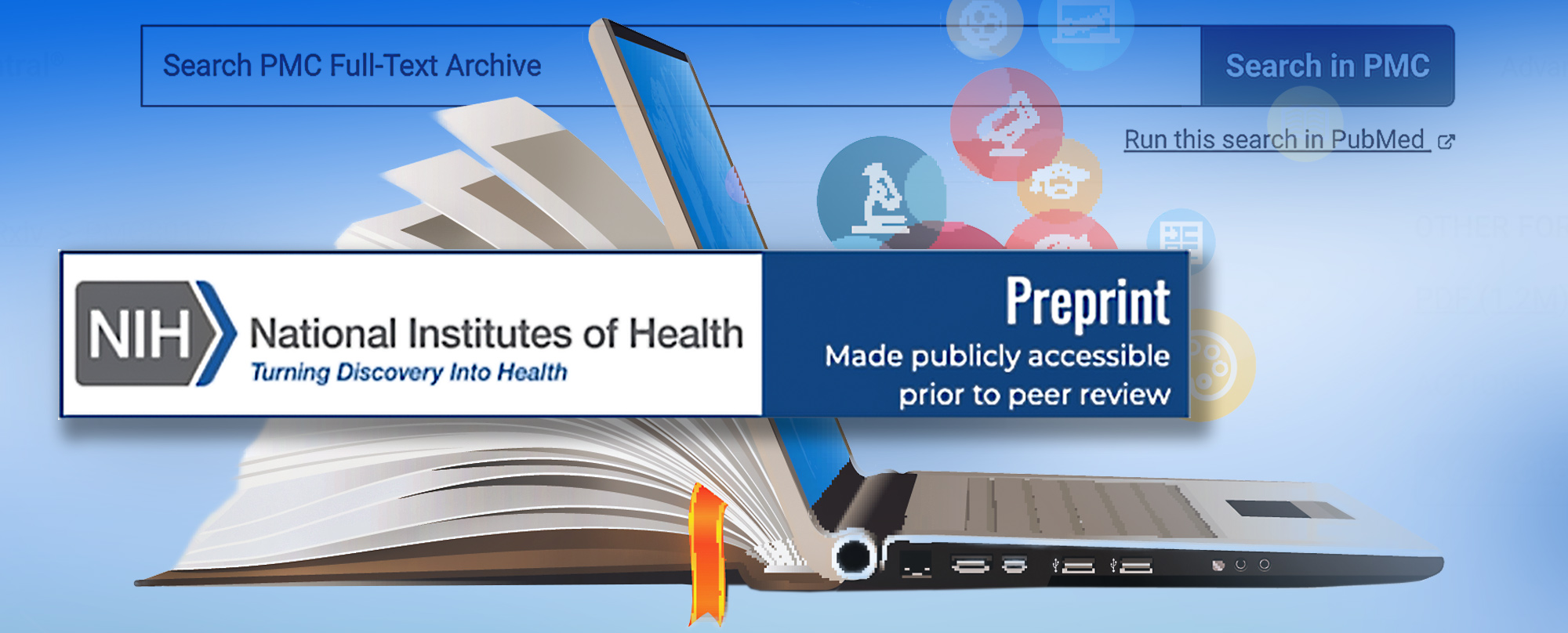Guest post by Kathryn Funk, program manager for NLM’s PubMed Central. Originally posted on the Musings from the Mezzanine blog.

In 2020, I shared information about NLM’s launch of the NIH Preprint Pilot: A New Experiment for a New Era to explore how inclusion of preprints in our literature resources, PubMed Central (PMC) and PubMed, could accelerate the discoverability and maximize the impact of NIH-supported research. Preprints are complete, public drafts of scientific documents that are not yet peer reviewed. We are now expanding into a second phase of the pilot to inform our understanding of the role of preprints in communicating the breadth of NIH-funded research. Coinciding with the designation of 2023 as the Year of Open Science, this second phase will run for a year and encompass all preprints reporting on NIH-funded research and posted to an eligible preprint server on or after January 1, 2023.
A 2016 NIH request for information found that scientists post preprints to speed dissemination, increase transparency of their research, and establish priority of discovery. Additional benefits noted include helping junior investigators obtain credit for their work, providing authors with the chance to incorporate feedback into their drafts prior to publication, and even form new collaborations. Preprints can also facilitate distribution of research results and related data that are not formally published (e.g., negative or null results). In ensuing years, NIH recognized the potential of preprints, predicting in the NIH-Wide Strategic Plan for Fiscal Years 2021-2025 that “[n]ew forms of scientific communications, such as preprints, will accelerate clinical research and shorten the evidence-to-practice cycle.”
The use of preprints in communicating the results of biomedical research surged during the COVID-19 pandemic. Through Phase 1 of the Preprint Pilot, which focused on NIH-funded research on COVID-19, more than 3,500 preprints were added to NLM literature databases. These preprints have been viewed 4 million times and 3 million times in PMC and PubMed, respectively. NLM’s analysis of Phase 1 of the Preprint Pilot found that inclusion of preprint records in NLM literature resources successfully broadened access to NIH research—accelerating access to NIH-supported research results by more than 100 days on average, a notable period of time during a public health emergency. These preprints also supported discovery in PMC and PubMed of nearly 1,000 articles posted as preprints reporting NIH research results that had not yet been published or may not have been intended for formal journal publication. Users reported during Phase 1 that the inclusion of preprints did not decrease users’ trust of NLM and its literature resources, with some users reporting increased trust due to greater transparency offered by preprint sharing into the research process.
To prepare for Phase 2, we’ve reviewed user feedback from Phase 1 and are taking steps to more clearly communicate what preprints are, their peer review status, and why they are included in NLM literature resources. We have also been exploring new strategies for presenting the record of versions in our literature databases and reviewing filter options to support different search and discovery workflows. We continue to develop materials to increase awareness of preprints and to consolidate resources of interest in our Librarian Toolkit.
What do authors and investigators need to know about Phase 2?
- For a preprint to be included in the pilot, it must be posted to a participating preprint server: bioRxiv, medRxiv, arXiv, or Research Square.
- Preprints must acknowledge direct NIH support or have an NIH-affiliated author. Investigators should follow guidance NIH released in March 2017 (NOT-OD-17-050) to enable identification of preprints with NIH support, including clearly acknowledging NIH support. Preprints that do not clearly acknowledge direct NIH support or only acknowledge indirect support will not be included in the pilot.
- NIH encourages investigators to select a Creative Commons Attribution (CC-BY) license or dedicate their work to the public domain. All preprints made available under a Creative Commons license will undergo full-text indexing in PMC to support preservation and greater discovery.
- New preprint records are identified by NLM staff and added to PMC weekly. However, it may take up to two weeks for a preprint to be added to PMC and PubMed. Preprints do not fall under the NIH Public Access Policy and therefore should not be deposited via the NIH Manuscript Submission (NIHMS) system. NIHMS is only for peer-reviewed author manuscripts that have been accepted for publication in a journal.
- Preprints can be reported to NIH as products of an award. NLM simplified the steps to add preprint citations to My Bibliography. See this video for details.
Building on the role of PMC as a repository for peer-reviewed articles supported by NIH under the NIH Public Access Policy, this next phase of the pilot will help us learn more about the emerging role of preprints in communicating biomedical and life science research results and accelerating and expanding discovery of those results. This includes how NIH-supported investigators make preprints available, how preprints are integrated into the scholarly record (including published journal articles and related data), how preprints are used in PMC and PubMed, and how engagement with preprints can play a role in accelerating scientific discovery. We also see this as an opportunity to gain an increased understanding of NLM’s role in engaging with these new forms of scientific communications to create a more interconnected and transparent scientific landscape.
We look forward to engaging with you throughout the year to hear your perspectives around preprints. Your feedback is always welcome at [email protected].





0 Comments